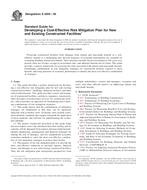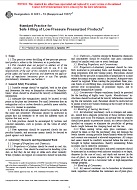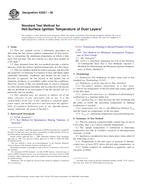Click here to purchase
1.1 This guide may be used to determine the outdoor-indoor noise reduction (OINR), which is the difference in sound pressure level between the free-field level outdoors in the absence of the structure and the resulting sound pressure level in a room. Either a loudspeaker or existing traffic noise or aircraft noise can be used as the source. The outdoor sound field geometry must be described and calculations must account for the way the outdoor level is measured. These results are used with Classification E1332 to calculate the single number rating outdoor-indoor noise isolation class, OINIC. Both OINR and OINIC can vary with outdoor sound incidence angle.
1.2 Under controlled circumstances where a single facade is exposed to the outdoor sound, or a facade element such as a door or window has much lower transmission loss than the rest of the facade, an outdoor-indoor transmission loss, OITL, or apparent outdoor-indoor transmission loss, AOITL, may be measured using a loudspeaker source. These results are a function of the angle of incidence of the sound field. By measuring with sound incident at many angles, an approximation to the diffuse field transmission loss as measured between two rooms can be obtained. The results may be used to predict interior sound levels in installations similar to that tested when exposed to an outdoor sound field similar to that used during the measurement.
The single number ratings of apparent outdoor-indoor transmission class, AOITC , using AOITL and field outdoor-indoor transmission class, FOITC, using OITL may be calculated using Classification E1332. These ratings also may be calculated with the data obtained from receiving room sound pressure measurements performed at several incidence angles as discussed in 8.6.
1.3 To cope with the variety of outdoor incident sound field geometries that are encountered in the field, six testing techniques are presented. These techniques and their general applicability are summarized in Table 1 and Figs. 1-6. The room, facade element declared to be under test is referred to as the specimen.
1.4 The values stated in SI units are to be regarded as standard. No other units of measurement are included in this standard.
1.5 This standard does not purport to address the safety concerns, if any, associated with its use. It is the responsibility of the user of this standard to establish appropriate safety and health practices and determine the applicability of regulatory limitations prior to use.
1.6 The text of this standard references notes and footnotes which provide explanatory material. These notes and footnotes (excluding those in tables and figures) shall not be considered as requirements of the standard.
Product Details
- Published:
- 09/01/2010
- Number of Pages:
- 15
- File Size:
- 1 file , 480 KB


